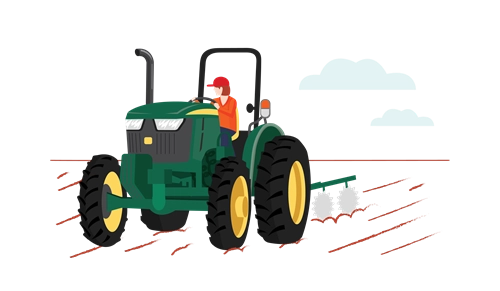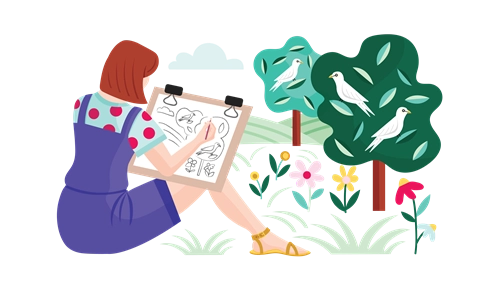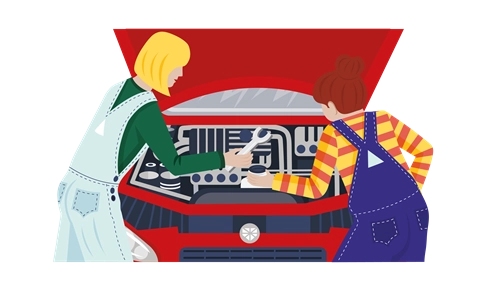- S
- T
- E
- M
Designing urban carbon sinks
Years 9 and 10
Learning hook
Ask students to think about their family’s travel in cars, trains or planes over the past week or month. Ask them to record the start and end point of each journey or the trip distance if they know it.
They can then use the carbon footprint calculator at to calculate their carbon emissions and the number of trees required to absorb that amount of C02.
As a class, discuss the strengths and limitations of the calculator. Do they think this is a fair way to calculate your carbon footprint? Explore whether they think carbon offset programs such as tree planting are a viable solution.
Learning input
One strategy that can partially combat global warming and climate change is to increase the amount of carbon stored in plants – that is, to create a ‘sink’.
These carbon sinks include plant material above ground, below ground (roots) and soil that is enriched in carbon by dead plant material.
Students can view this video about carbon sequestration in primary industry and read this article to develop a broad understanding of carbon farming.
Girls in focus
Girls may not appreciate the value that early career scientists can bring to contemporary debates about climate solutions. They may appreciate the field experiences recounted by Bonnie Waring from the Grantham Institute and also the way in which she outlines the complexity of designing socio-scientific solutions.
Learning construction
In urban areas, vegetation and soils can play a role as carbon sinks. Proponents of urban carbon farming initiatives also point out that vegetation and soils can provide other ecosystem services, such as improved stormwater management, recreation and even food production. See the ABC Science article ‘Cities can be carbon sinks too: study’ for more information.
Students will explore local areas to determine current carbon sinks and develop a proposal to improve carbon storage in the future.
- Have students use Google maps to identify significant green spaces in your local area and identify at least two sites to compare. Use the scale in the bottom right-hand corner of the screen to estimate the size of each site. Note: consider selecting a site close to the school, not too large and easy to walk around. This will enable easier field studies.
- Switch to satellite view, identify zones within the park and estimate the percentage of tree cover for each zone.
- Ask students to individually construct a hypothesis regarding which site represents the larger carbon sink.
- Ask students to work collaboratively in teams of four or five to design a method for a field investigation to test their hypothesis. Depending on the size of the site, they can determine whether they map the entire site or whether they will map a sample.
Some ideas students might like to consider:
- They could use this calculator to estimate the amount of carbon stored in a tree or shrub. They’ll also need a tape measure. Note that in this calculator, CO2-e refers to carbon dioxide equivalent – students only need to use the measure of stored carbon.
- They could estimate the amount of leaf litter by measuring depth of leaf litter across different zones in the park
- They could estimate the amount of deadwood in different zones of the park.
- Once they have designed their method, students should compare their ideas with others and discuss the relative merits of different approaches. They can adapt their methods following this discussion.
- Students plan their field work, including researching the significance of the site to First Nations Australians, and any cultural protocols that should be followed. Students then collect data to estimate the carbon storage represented by each site.
- Back in class, support students to represent and analyse the data. They should share and discuss their findings as a class and have the opportunity to revise their representations following this discussion.
- Following discussion, students work individually to construct a report to share their findings, including a recommendation for ways to improve the value of the sites as a carbon sink while considering community values
Girls in focus
Girls often assume that STEM careers require independent, isolated endeavours. By demonstrating how STEM communities work together to refine practices and ideas, you can begin to combat these stereotypes.
-
Rubric
Assessment
Criteria
Beginning
Achieved
Exceeded
Methodology
Method enables data collection.
Method enables collection of valid, representative data.
Method is reproducible and enables collection of valid, representative data.
Data collection
Uses equipment safely to collect data.
Selects equipment and uses it safely to collect useful data.
Selects equipment and uses it safely and efficiently to collect useful, replicable data.
Data analysis
Estimates and represents carbon storage in trees and/or shrubs for the two sites.
Estimates and represents carbon storage for the two sites using multiple data sets.
Estimates and represents carbon storage for the two sites using multiple data sets and includes consideration of uncertainty.
Site improvement recommendation
Provides a recommendation for improving carbon storage.
Provides actions to improve carbon storage that show consideration of community values.
Provides actions to improve carbon storage and explains how this approach balances community values and environmental goals.
Report
Report communicates key ideas, findings and arguments, including selection of some appropriate content, language and text features.
Report clearly communicates ideas, findings and arguments including appropriate use of content, language and text features.
Report communicates ideas, findings and arguments effectively, including selection of appropriate content, language and text features.
Resources
- Calculate and reduce your flight’s carbon footprint (EcoTree)
- Carbon Explainer video series (Landscape South Australia)
- There aren’t enough trees in the world to offset society’s carbon emissions and there never will be (Bonnie Waring, The Conversation)
- North Sydney Council Carbon Calculator
- Carbon farming in Australia (Queensland Government)
- Cities can be carbon sinks too: study (ABC Science)











